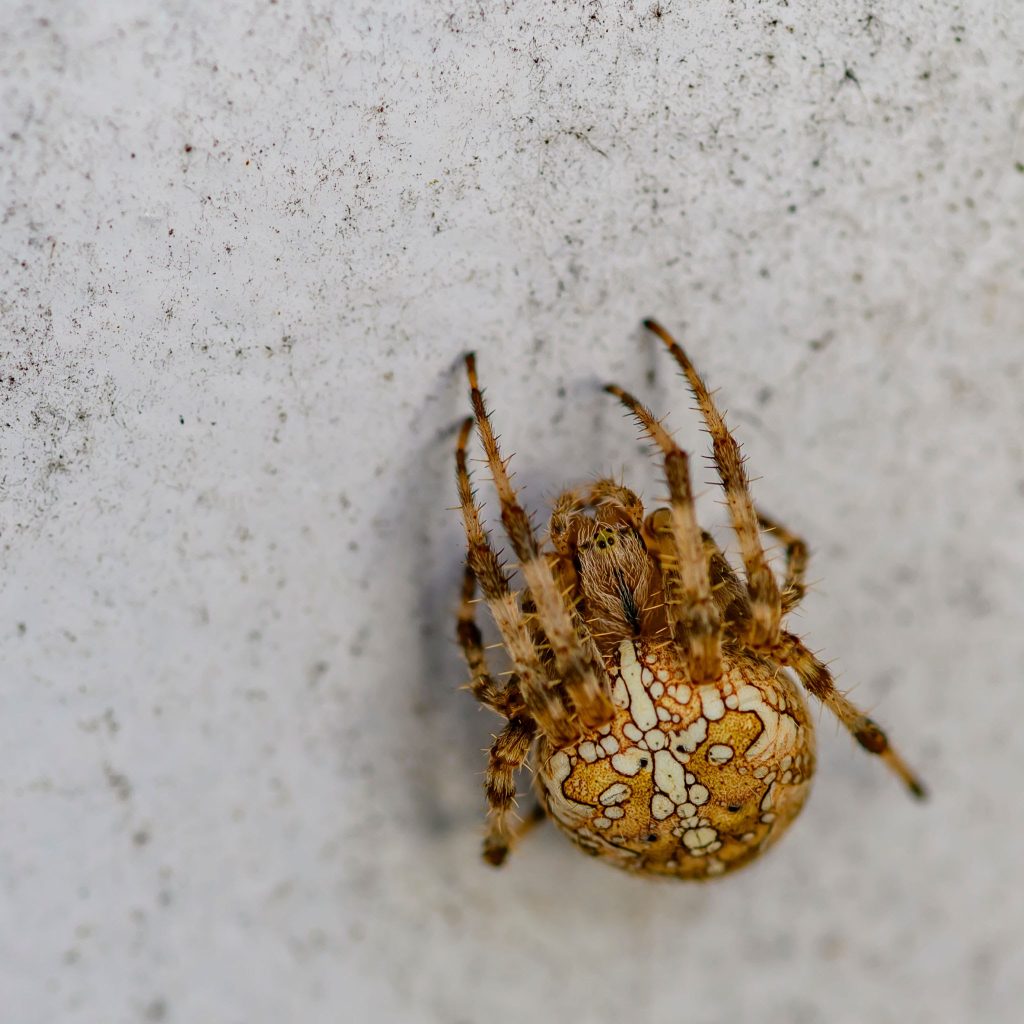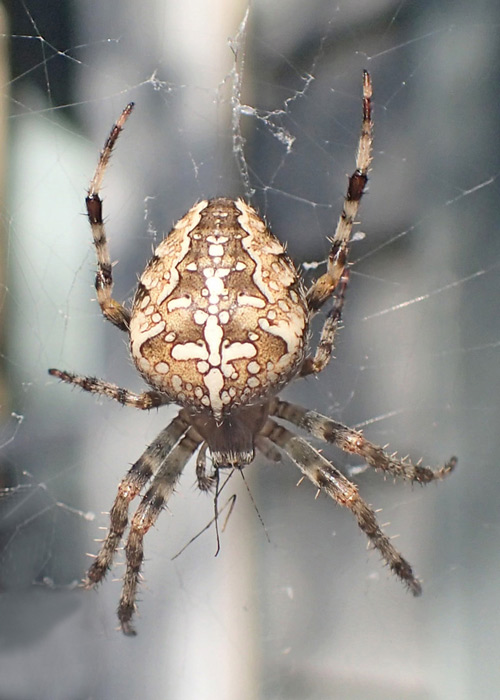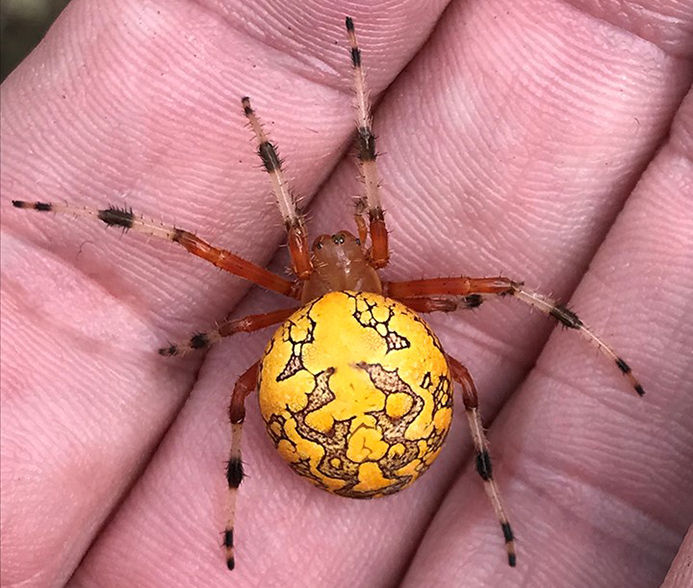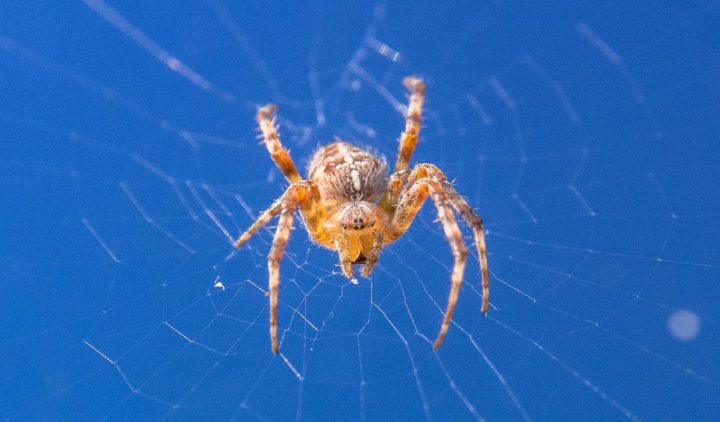Angulate orbweavers Pictures



Angulate orbweavers Habitat Information
These rather large spiders are common in open woods, brushy fields, in tall grassy areas, and around fenceposts and buildings. They are common on the eaves of houses and barns. They may build their webs wherever structures are present for support and where flying insects commonly pass through.
Scientific Name:Araneus spp.
Family:Araneidae (typical orb-weavers) in the order Araneae (spiders)
Description:Missouri has several species of orb-weaving spiders in genus Araneus, which specialists call, as a group, the “angulate and roundshouldered orbweavers.” Some are quite difficult to distinguish, even by specialists. Often, you must observe small details of their anatomy in order to determine the species.
Two Araneus species common in Missouri are the marbled orbweaver (A. marmoreus) and openfield orbweaver (A. pratensis).
Similar species: Neoscona species may be similarly marked and colored, though some are quite hairy. To separate the two genera of “barn spiders,” one must examine the fovea (which is a groove, pit, furrow, or other depression in the center of the carapace, the shieldlike covering of the cephalothorax, the “head” part of the spider’s body). In genus Araneus, the fovea comprises angular or transverse grooves, running side to side or diagonally across the spider’s body; in some Araneus species the fovea is little more than a dimple. In genus Neoscona, the fovea is a lengthwise groove, parallel to the length of the spider’s body.
Other Common Names:
Arboreal Orb Weavers
Araneus Orbweavers
Barn Spiders
Size:Length: usually to no more than about ½ inch (not including the legs); males are smaller than females.
Food
Flying insects such as moths and crane flies are the principal prey. Once caught in sticky strands of the web, they are bitten and trussed by the spider, which later eats them. Many orbweavers are nocturnal and have the peculiar habit of eating and rebuilding their webs each day. Webs are built at dusk and used for snaring prey during the night. At dawn, the spider reingests the strands (along with moisture that has collected on it as dew) and recycles the nutrients in making the next web.
Life Cycle
Life CycleEggs hatch in spring and the young spiderlings disperse and begin building webs, hunting, and growing. Males do not spin webs. Once mature, the males wander in search of a mate, and the females hang in webs eating and awaiting a mate. Once mated, the female keeps eating and creates egg cases. The first freezes usually kill all the adult spiders, with only the eggs overwintering.
Human Connections
The amazing web patterns have fascinated humans for millennia.
E. B. White wrote his classic “Charlotte’s Web” about a spider in genus Araneus.
Orbweavers control populations of flying insects, many of which are pests.
Orbweavers don’t bite unless molested, and their bites are not dangerous, anyway.
These are some of the spiders that commonly build their webs right across trails. An oldtime Ozark folk belief held that if you encounter a big orbweaver right in the middle of your path, you’ll be getting a letter within a few days.
Ecosystem Connections
These spiders control populations of flying insects.
Although they may seem ferocious, outside their webs and hiding places these delicate creatures are quite vulnerable to predation themselves. Also, their egg sacs are relished by many species and provide winter food for many birds.
Orb Weaver Spiders
Orb Weaver Spiders This family of spiders is a very large one and includes over 2800 species in over 160 genera worldwide, making it the third largest family of spiders known behind the jumping spider family (Salticidae) and the second largest family of spiders called Linyphiidae commonly known as Sheet Weavers because of the shape of their webs.
The oldest known orb-weaving spider is ‘Mesozygiella dunlopi’, an extinct species of orb-weaving spider with specimens found in amber dating from the Lower Cretaceous period.

Orb Weaver Spider Characteristics
Because there are so many different species of Orb Weavers, they differ in color shape and size. The commonly seen Garden Orb Weavers are 2 to 3 centimetres in length for the female and 1.5 to 2 centimetres for the male in body length. Most are stout, reddish-brown or grey spiders with a leaf-shaped pattern on their fat, roughly triangular abdomens, which also have two noticeable humps towards the front. Orb Weaver Spiders sometimes have a dorsal stripe which may be white or brown edged with white.
Golden Orb Weavers are large spiders with a body length of 2 to 4 centimetres with silvery-grey to plum colored bodies and brown-black, often yellow banded legs. The males are tiny measuring only 5 millimetres and red-brown to brown in color. The main difference between the common Sydney species (Nephila plumipes) and Nephila edulis (which is more common in inland regions) is the presence of a ‘knob’ on the front of the sternum (the heart shaped plate on the underside of the body between the legs) of Nephila plumipes.
Humped Orb Weavers or Silver Orb Weavers are easily recognised by their silvery body, with yellow or green and black markings. They have long bodies and long limbs, with a body length of about 1 centimetre. The abdomen often has rounded ‘shoulder’ humps that give these spiders their common name.
Orb Weaver Spider Gallery
Orb Weaver Spider Habitat and Webs
Orb-weaving spiders are three-clawed builders of flat webs with sticky spiral capture silk. The building of a web is an engineering feat, begun when the spider floats a line on the wind to another surface. The spider secures the line and then drops another line from the centre, producing a ‘Y’ shape. The rest of the web is then constructed before the final sticky capture spiral is woven into place. Some species of Orb Weaver spiders remain in their webs day and night.
Some Orb Weaving spiders do not build webs at all. Members of the genera Mastophora in the Americas, Cladomelea in Africa and Ordgarius in Australia produce sticky globules instead, which contain a pheromone analog (a chemical that triggers a natural behavioural response in another member of the same species). The globule hangs from a silken thread dangled by the spider from its front legs. The pheromone analog attracts male moths of only a few species. These get stuck on the globule and are reeled in to be eaten. Interestingly, both types of bolas spiders (unusual orb-weaver spiders that have given up spinning the typical web. Instead, they hunt by using a sticky ‘capture blob’ of silk on the end of a line) are highly camouflaged and difficult to locate.
One feature of the webs of some orb-weavers is the ‘stabilimentum’, a crisscross band of silk through the centre of the web. It is found in a number of genera, but Argiope, which includes the common garden spider of Europe as well as the yellow and banded garden spiders of North America, is a prime example. The band has been hypothesized to be a lure for prey, a marker to warn birds away from the web and a camouflage for the spider when it sits in the centre of the web.
Humped Orb Weavers build small flimsy, horizontal webs among shrubs and grasses or over water. They remain in their webs during the day and capture flies and other small insects.
Most arachnid webs are vertical and the spiders usually hang with their head downward. A few webs, such as those of orb-weaver in the genus Metepiera have the orb hidden within a tangled space of web. Some Metepiera are semi-social and live in communal webs.
Orb Weaver Spider Diet
Orb Weaver spiders mainly each insects as their main diet.
Orb Weaver Spider Venom
Orb Weavers are usually reluctant to bite. Symptoms of an Orb Weaver bite is mild local pain, numbness and swelling. Occasionally nausea and dizziness can occur after a bite. Humped Orb Weavers have very small fangs and they are timid and reluctant to bite.
Orb Weaver Spider Reproduction
The female Garden Orb Weaver lays her eggs in late summer to autumn. The eggs are encased in a fluffy silken cocoon and attached to foliage. The life span is about 12 months. They mature in summer, mate, lay their eggs and die in late summer-autumn. Males and females are similar in size. During autumn, the spiderlings disperse by ballooning (floating on the breeze using small silk strands as ‘balloons’) and build their own tiny orb webs among vegetation.
In the Golden Orb Weaver group, it is common for a number of tiny (6 millimetre) males to live around the edges of a females web, waiting for a mating opportunity. After mating, the female Golden Orb Weaver wraps her single egg sac in a mass of golden silk, which is then hidden on foliage away from the web, disguised within a curled leaf or sprig of twigs.
Predators of orb weavers include several bird species and wasps of the family Sphecidae. The wasps land on the web, lure the spider to the perimetre by imitating a struggling insects vibrations and then carry the spider away to be paralysed and stored as live food for their young.
